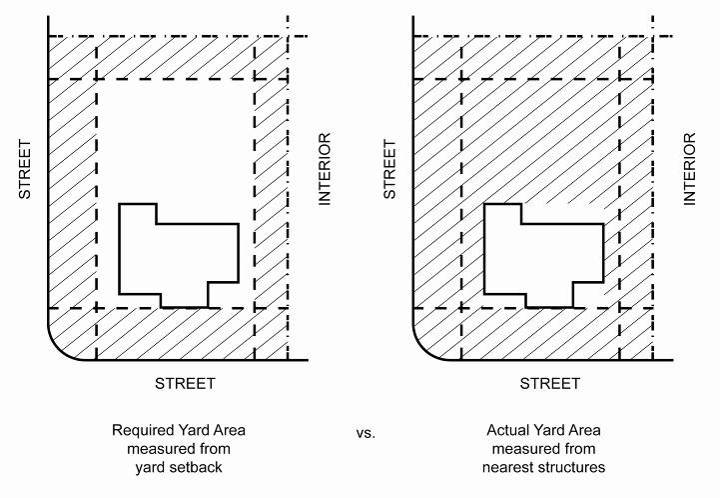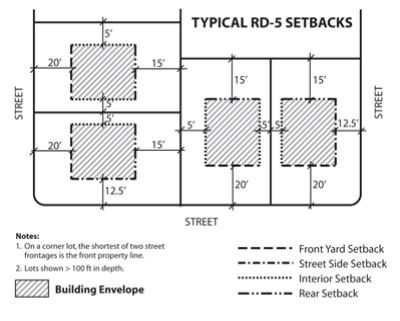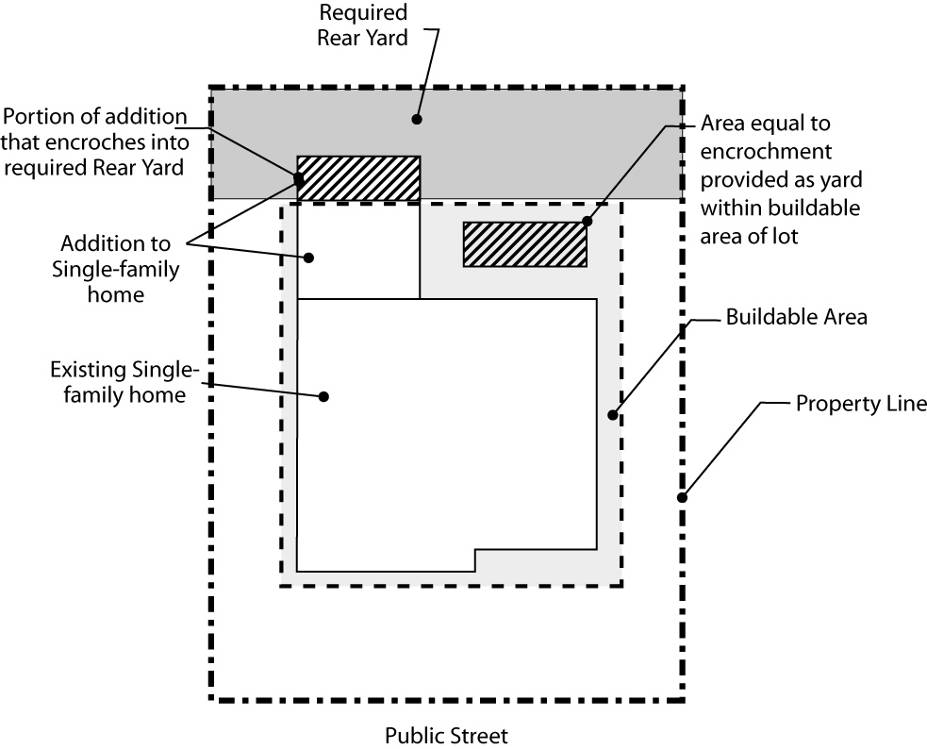Chapter 23.64
YARD MEASUREMENTS AND PROJECTIONS
Sections:
23.64.030 Required yard areas.
23.64.035 Lot area measurement.
23.64.040 Setback measurements.
23.64.045 Light and air easements.
23.64.050 Allowed encroachments/projections into required yards.
23.64.010 Purpose.
The purpose of this chapter is to establish rules and regulations for setback measurement, yard areas, and encroachments. These provisions, in conjunction with other applicable provisions of this title, are intended to ensure open areas around primary structures, maintain clear visibility for traffic safety and pedestrian access, buffers between property and land uses, and establish natural and visual light and air space privacy, landscaping and recreation. [Ord. 26-2006 §3, eff. 8-11-2006]
23.64.020 Definitions.
Terms unique to this chapter are listed in EGMC Chapter 23.100 (General Definitions). [Ord. 8-2011 §30(A), eff. 6-24-2011]
23.64.030 Required yard areas.
The required yard area (front, interior side, street side, and/or rear) of a lot is the horizontal area between the property line and the minimum setback distance for the respective yard pursuant to Division III, Zoning Districts, Allowable Land Uses, and Development Standards, of this title. Except as otherwise specified in this title, required yard areas shall be kept free of buildings and structures. See Figures 23.64-2 and 23.64-3.
Figure 23.64-2
Required vs. Actual Yard Area
Figure 23.64-3
Typical Single-Family Residential Building Envelope
[Ord. 12-2012 §11(B), eff. 7-27-2012; Ord. 28-2007 § 3, eff. 10-26-2007; Ord. 26-2006 §3, eff. 8-11-2006]
23.64.035 Lot area measurement.
Unless otherwise specified, lot area shall be calculated using gross rather than net areas. [Ord. 8-2011 §30(B), eff. 6-24-2011]
23.64.040 Setback measurements.
All setback distances shall be measured at right angles from the designated property line (e.g., front, interior side, street-side, rear) and the setback line shall be drawn parallel to the designated property line at the required setback distance, except as follows:
A. The rear yard setback on the street side of a double frontage lot is a line parallel to the rear property line abutting the street. However, if an access easement or street right-of-way line extends into or through a rear yard, the minimum rear yard setback distance shall be measured at right angles from the access easement or right-of-way line; and
B. Where the side lot lines converge to a point with two (2) or three (3) lines, the rear yard setback shall be measured from an imaginary line drawn parallel to the front property line from a distance of ten (10' 0") feet from the point at which the lines converge. [Ord. 26-2006 §3, eff. 8-11-2006]
23.64.045 Light and air easements.
Light and air easements are easements intended to keep a certain area free of visually obstructive structures. For purposes of this section, “structures” shall not include the following as defined in this title:
A. Pools and spas;
B. Play equipment (including sports courts);
C. Decks, patios, and other flatwork;
D. Features that are less than one hundred twenty (120 ft2) square feet with limited or no enclosure and with substantially open roofs; and
E. Property line fencing installed in compliance with the EGMC. [Ord. 24-2015 §11 (Exh. I), eff. 2-12-2016; Ord. 8-2011 §30(C), eff. 6-24-2011]
23.64.050 Allowed encroachments/projections into required yards.
A. In addition to the detached structures listed in Chapter 23.46 EGMC, Accessory Structures, and Chapter 23.52 EGMC, Fences and Walls, the following structures and architectural features attached to the main building may project into required yards as listed in Table 23.64-1:
|
Structures |
Encroachment Distance into Required Yard |
||
|---|---|---|---|
|
Front Yard |
Side Yard |
Rear Yard |
|
|
Fireplaces, bay windows, porches, pergolas, awnings, trellises and decks and patios higher than 30 inches above grade |
2 ft.1, 2 |
||
|
Canopies, cornices, eaves, and roof overhangs |
2 ft.1 |
||
|
Uncovered porches or stairways, fire escapes or landing places higher than 30 inches above grade |
6 ft.1 |
4 ft. or 1/2 required setback, whichever is less1 |
6 ft.1 |
Notes:
1. However, all such encroachments shall maintain a minimum three (3' 0") foot setback from all property lines and the minimum distance between other buildings under EGMC Chapter 16.04 (California Building Code).
2. The combined length of all such features shall not account for more than twenty-five (25%) percent of the length of the wall surface on which the features are located.
B. For single-family residential development, the following encroachments/projections are allowed by right:
1. A portion of the main building may project into the required rear yard area; provided, that an equal area of the buildable portion of the lot (this area can be anywhere on the lot) is provided as a yard or court (see Figure 23.64-4). In no event shall the rear yard be less than ten (10' 0") feet for one (1) story buildings and fifteen (15' 0") feet for two (2) and three (3) story buildings.
Figure 23.64-4
Main Building Projections into the Rear Yard for Single-Family Development
2. Structures that are attached to the primary dwelling and that have limited or no enclosure (e.g., patio covers) are allowed to project into the required rear and interior side yard setbacks, provided they maintain a minimum five foot (5' 0") setback from the rear and interior side property lines. This allowance shall not be subject to the requirements of subsection (B)(1) of this section. [Ord. 23-2014 §3 (Exh. A), eff. 10-10-2014; Ord. 12-2012 §11(A), eff. 7-27-2012; Ord. 28-2007 §3, eff. 10-26-2007; Ord. 26-2006 §3, eff. 8-11-2006]


